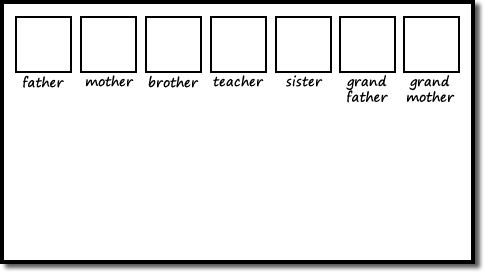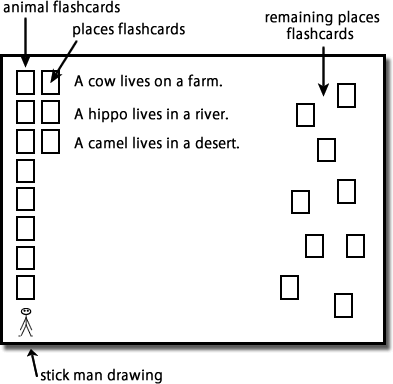Download a new song from ESL KidStuff: The Wheels on the Bus
![Wheels on the Bus]() The Wheels of the Bus
The Wheels of the Bus
Song Theme: Talking about travelling on the bus
Target Vocab: bus, wheels, go round, town, wipers, go swish, horn, goes beep, doors, open, shut, babies, go boo-hoo, driver, sit down.
Song Length: 1:58
A fun song with great vocab.
(Members can log in to download the full song)
Lyrics:
Verse 1:
The wheels on the bus
Go round and round
Round and round
Round and round.
The wheels on the bus
Go round and round
All around the town.
Verse 2:
The wipers on the bus
Go swish, swish, swish
Swish, swish, swish
Swish, swish, swish.
The wipers on the bus
Go swish, swish, swish
All around the town.
Verse 3:
The horn on the bus
Goes beep, beep, beep
Beep, beep, beep
Beep, beep, beep.
The horn on the bus
Goes beep, beep, beep
All around the town.
Verse 4:
The doors on the bus
Go open and shut
Open and shut
Open and shut.
The doors on the bus
Go open and shut
All around the town.
Verse 5:
The babies on the bus
Go “Boo-hoo-hoo!
Boo-hoo-hoo!
Boo-hoo-hoo!”
The babies on the bus
Go “Boo-hoo-hoo!”
All around the town.
Verse 6:
The driver of the bus
Says “Please sit down!
Please sit down!
Please sit down!”
The driver of the bus
Says “Please sit down!
All around the town.
Verse 7:
The wheels on the bus
Go round and round
Round and round
Round and round.
The wheels on the bus
Go round and round
All around the town.
Gestures and activities to use with “The Wheels on the Bus” song
The actions of the song are really easy and mimic what is happening in the song.
- For verse 1, whirl your arms around in the air for “The wheels on the bus go round and round …” part.
- For verse 2, swish your arms lefts and right for “The wipers on the bus go swish, swish, swish …” part.
- For verse 3, beep an imaginary horn for “The horn on the bus goes beep, beep, beep …” part.
- For verse 4, swish your arms back and forth for “The doors on the bus go open and shut …” part.
- For verse 5, put your fists to your eyes and mimic crying for “The babies on the bus go boo-hoo-hoo …” part.
- For verse 6, look angry and wave your finger for “The driver on the bus says “Please sit down” …” part.
- Verse 7 is the same as verse 1
Using ”The Wheels on the Bus” song in class
This is a really popular song which kids just love to sing along to. The song introduces some great vocab and makes for a good ‘present simple’ lesson.
- Introduce the vocab with a drawing exercise. For this lesson you are going to use your artistic drawing skills.
- Start by drawing a large picture of a bus on the board – make it as large as you can, filling the whole board. Elicit / teach / chorus the word “bus”.
- Next, shade in the wheels and again elicit / teach / chorus the word “wheels”. Now teach the action word “go round and round” and get everybody making round and round movements with their arms as you say “The wheels on the bus go round and round”.
- Now draw wipers onto the picture and teach “wipers” and “swish” and get everyone to do the swishing action with their arms.
- Then draw a steering wheel (through the window) and motion driving and honking the horn. Teach and practice “horn” and “beep”.
- Draw the doors on the bus and teach “doors”, “open and shut” and practice do opening and shutting actions with your arms.
- Now for the tough bit – drawing babies on the bus! Draw the windows and draw babies looking out. You can show flashcard pictures if your drawing is not up to scratch! Teach and practice “babies”, “boo-hoo”.
- Finally, draw the driver sitting on the bus holding the steering wheel. Teach / practice “driver”, “Please sit down”. When teaching “Please sit down” get everyone standing up and have fun telling everyone to sit down and stand up, so they all get the meaning.
- Play “I say, you do”. Now to practice the vocab. Get everyone to stand up facing the teacher. Start by saying a random sentence from the song (e.g. “The doors on the bus go open and shut”) and get everyone to do the action. At first go slowly, saying different sentences and having everyone do the action from the gestures section above. Then go faster and faster until it is impossible to keep up.
- Sing “The Wheels on the Bus”. First play the song and get everyone to follow you with the actions. Then play the song again and encourage everyone to sing along.
- Draw the bus pair work activity. Put everyone in pairs and give them a large piece of plain paper (A3 size is good). Each pair will have to cooperate to draw the same picture as yours on the board. Give the first instruction “Everybody draw a bus” and encourage each pair to work together to draw the outline of the bus. Then give the next instruction “Now draw the wipers”. As they are doing so ask random students what wipers do (“swish- swish-swish”). Keep going until all the pictures are complete and colored in. Finally, pin all the pictures to the walls and have each pairs stand in front of their pictures. Play the song one more time, and have the students touch the parts of the picture as it is mentioned in the song (e.g. they touch the wipers on the line “The wipers on the bus go swish, swish, swish”)
- Do a “Take the Bus” role-play. This is the show stopper which your students will love. Arrange all the chairs so that they are facing forwards in rows, just like on a bus. The teacher can be the driver (if you can find a driver’s cap to wear, all the better!). Get everyone to line up outside the bus (at the bus stop) and ‘drive’ the bus to the bus stop. Everyone can enter the bus, pay for their ticket (prepare tickets before class and ever use toy money) and then sit down. Then start driving the bus and as you go, shout out “lean left!” and “lean right” as you go around corners and get everyone to lean with you. Do lots of other fun things, such as:
- beep the horn (everyone does together)
- stand up and sit down to help go up and down hills (Don’t forget to say “Please sit down”)
- stop!!! (everyone lurches forward)
- speed up!!! (everyone is pushed back in their seats
- jump up and down (when the bus gets stuck in mud)
At the end, pull up to the stop and shout “Everybody, get off the bus!” You can even invite other students to take on the role of bus driver.
- Set Homework: For homework, give out the “Bus Draw” worksheet.
Related Stuff:
- Download all songs
- The Hello Song and The Goodbye Song
- The Numbers Song
- The ABC Song
- Head, Shoulders, Knees & Toes
- The Rainbow Song
- Old MacDonald
- What Can You Do?
- The Feelings Song
- The Days of the Week Song
- Months March song
- How Did You Get Here Today?
- Mr. Shape Head
- Let’s Go to the Zoo
- What Fruit do you Like?
- Where are my Things?
- The Morning Routines Song
- If You’re Happy and You Know It
- What Time is it?
- What’s Wrong? What’s the Matter?
- Numbers 1-20


























